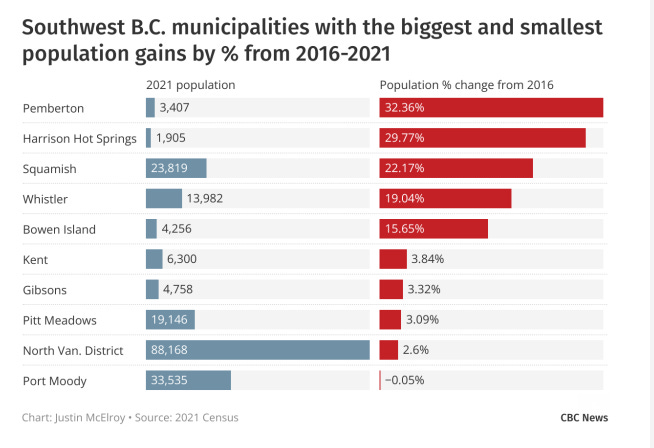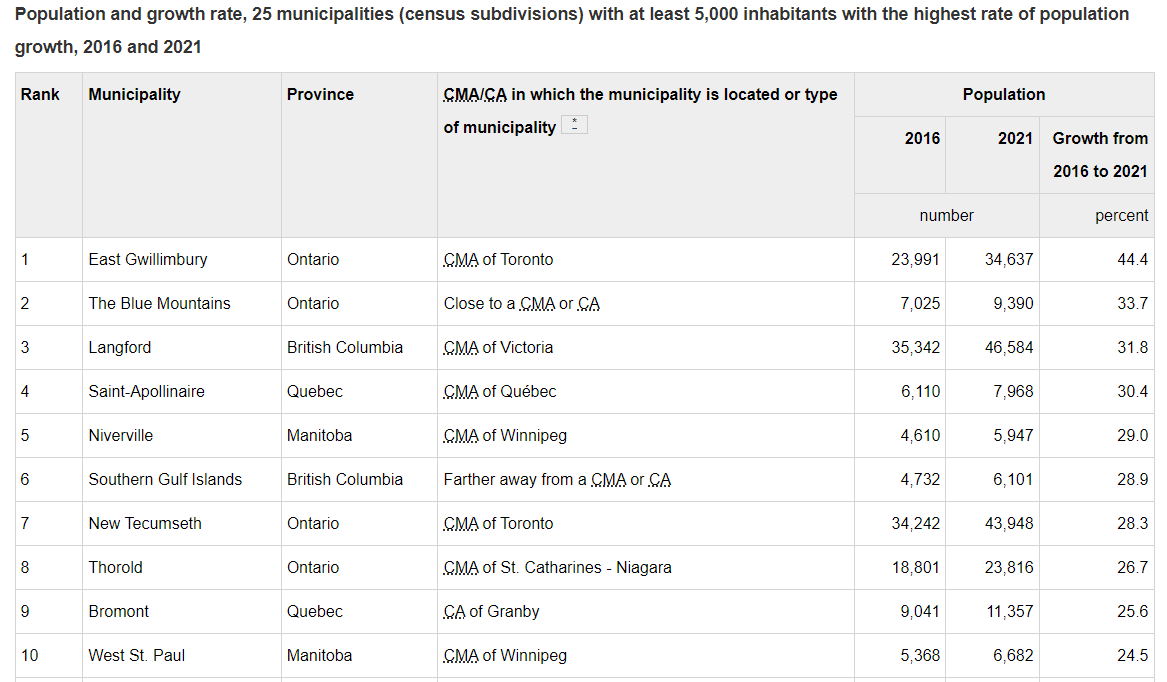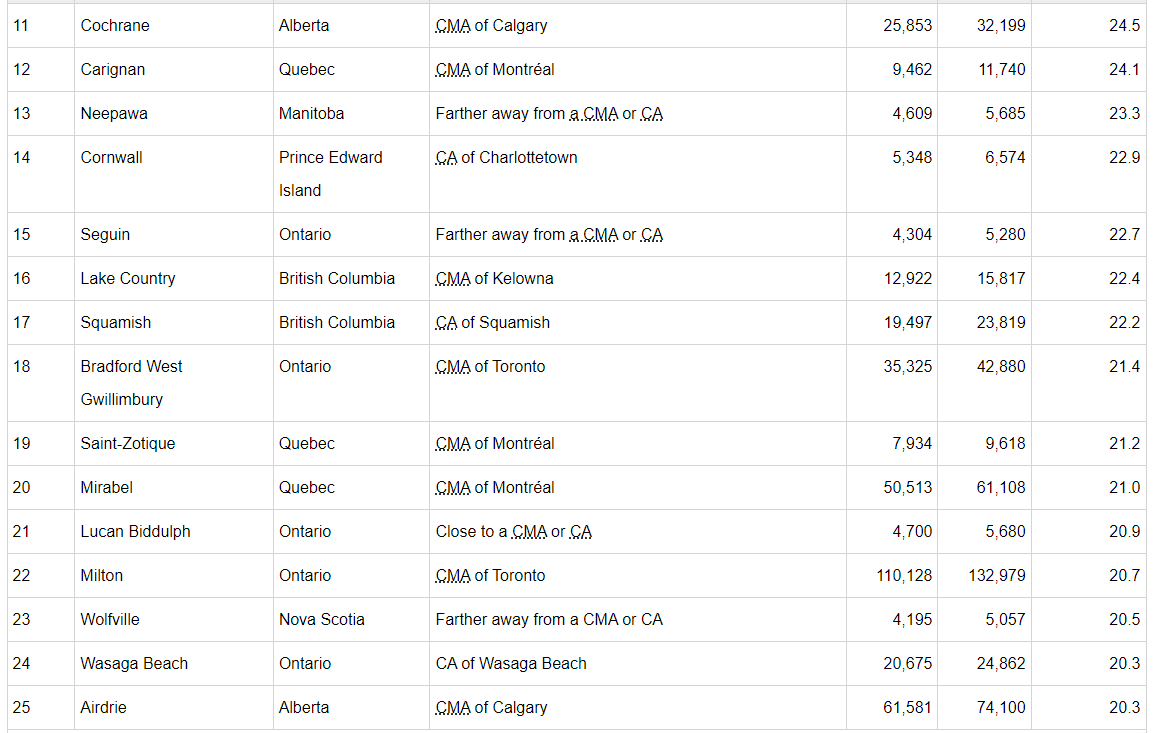SIDEBAR - What the 2021 Census means for Canada's municipalities
The first set of numbers from Canada's 2021 census has been released reveals a bit of what is going on with Canada's municipalites
Welcome to another issue of #munipoli Matters, where we discuss all about municipal elections and the often unreported area of local government across Canada and beyond. For this sidebar, I wanted to dive into the recently released Canadian 2021 Census.
The total population numbers were released on February 9. Nationally, Canada clocked in at 36,991,981 people, a 5.2% increase from 2016. As per the focus of #munipoli Matters this year on elections, here are the population numbers for the four provinces with either provincial and/or municipal elections:
Ontario: 14,223,942 - up 5.8% from 2016.
Quebec: 8,501,833 - up 4.1% from 2016.
British Columbia: 5,000,879 - up 7.6% from 2016.
Manitoba: 1,342,153 - up 5% from 2016.
Prince Edward Island: 154,331 - up 8% from 2016.
Newfoundland and Labrador and the Northwest Territories were the only province/territory to show a population decline, while the Yukon saw the highest percentage increase at 12.1%.
Let’s take a look at some other charts from the census for population numbers of specific municipalities, such as this one outlining the population growth in 25 of Canada’s largest cities.
Mississauga is the only major city on this list that saw it’s population decline, from 721,599 in 2016 to 717,961 in 2021. Canada’s sixth largest city will now have to amend that moniker, as that title now belongs to Winnipeg at 749,607.
In nearby Brampton, the population jumped by over 10%, as the city welcomed almost 63,000 residents. The newest cities to hit over 1 million residents are Ottawa and Edmonton. Over on the West Coast, Surrey, BC’s growth at 9.7% almost made them get into the top ten, only outpaced by Hamilton by about 1,000 people.
Speaking of British Columbia, below is a compilation of growth of certain BC municipalities. As you can see, smaller communities experienced a significant population boom in the past five years.
This is not just a BC phenomenon, as smaller communities across Canada have also seen a significant population increase from 2016 to 2021.
Being from the GTA, I have definitely seen the growth occurring in places such as East Gwillimbury, Bradford and Milton.
Here are some of my thoughts about these census population numbers.
Is Mississauga on the (population) decline?
The city’s own analysis showed that they anticipate over 900,000 by 2051, which is a good indicator that Mississauga may hit 1 million people in the coming decades. But as the 2021 census showed, the population may be plateauing, perhaps declining, in the years ahead.
Decade after decade of unimaginative suburban development under former mayor Hazel McCallion’s leadership, with zero to little effective planning for future generations, has led to an affordable housing crisis where a more varied mix of housing options would be better suited to attract, retain and lure more residents with more diverse backgrounds.
Mississauga’s recent overtures to redevelop its ‘downtown’ to more transit-oriented and denser communities is an admirable attempt at reverse engineering, but it may be coming too little too late.
To be fair, housing affordability is an issue not limited to Mississauga, but the fact that it is the only significant large city of its size to lose population, no matter how small the drop is, suggests the consequences of this bland and unimaginative form of development have come home to roost.
Higher growth percentage suggests ample land to build smarter
Out of the 25 largest municipalities only Brampton, London, Kitchener and Oakville have double digit percentage growth, each just around 10%. My bird’s eye view of these four particular cities is that there is still ample room for development and growth.
Unlike Mississauga, Brampton still has some land that can be developed, as do Kitchener and Oakville. As the only major “metropolitan” city in the Southwestern Ontario region past Hamilton, London still has ample room to expand its boundaries. The common denominator between these four cities experiencing a double digit percentage in growth: room to expand.
I hope in the coming decades these four cities don’t confuse ‘room to expand’ as an excuse to continue suburban sprawl like their predecessors did. Having that space to develop is an opportunity to build smarter and more creatively.
COVID-19’s effect on Canadians’ preferred living arrangements
That creativity is sorely needed after what we’ve all experienced these past two years.
Physical isolation and requirements for more space in our lives contributed to this growing trend of moving away from big cities to smaller communities where more of one’s personal space can be achieved.
But even before the pandemic arrived at our doorsteps, housing was becoming more expensive in the Greater Toronto and Vancouver area already; COVID-19 only exacerbated the move of younger families and others to the outskirts of the most populated areas of Canada seeking cheaper housing.
More numbers detailing demographics, income, and other data sets are scheduled for release throughout 2022, culminating by the end of November. Some may feel some concern over population growth, but some believe it is manageable, or should be welcomed.
If you like what you read, please give a follow by subscribing to get more #munipoli news sent directly to your inbox.










